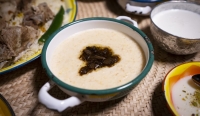
Traditional Food in Riyadh Province refers to the most renowned dishes prepared in Riyadh Province , located at the center of the Kingdom of Saudi Arabia. The province is known for its wide and varied traditional cuisine involving the use of ingredients mainly consisting of ghee, whole wheat flour, and meat, ultimately reflecting the province's traditional culture in cooking and serving these dishes. Common traditional dishes between Riyadh and Qassim Provinces Riyadh Province shares sever...
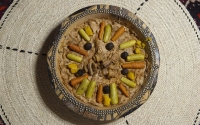
Traditional Food in Tabuk Province refers to dishes made by the inhabitants of Tabuk Province , located northwest of the Kingdom of Saudi Arabia. These dishes include seafood and traditional local dishes. They also vary according to the weather, as residents are keen to balance their love for seafood and meat-based dishes that supply warmth during winter. Moreover, some traditional dishes are served throughout the year. Mafroukeh or Jamriyah Due to the cold winter weather prevailing in Tabuk Pr...
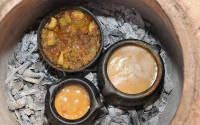
Traditional Food in Jazan Province refers to the most renowned dishes prepared in Jazan Province . These include coastal food, such as fish, mountainous food, such as meat, honey, and ghee, and food grown in plains, such as grains and vegetables. Diversity of traditional food in Jazan Province Traditional food in Jazan Province varies in terms of their method of preparation or serving in that they are served in clay containers dedicated to each dish. These dishes include: Al-Marsah It is a swee...
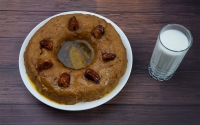
Traditional Food in Aseer Province refers to the most renowned dishes in the cities and towns of Aseer Province , located southwest of the Kingdom of Saudi Arabia. Ingredients used for those dishes, such as ghee, honey, whole wheat, and lamb and goat meat, offer high nutritional values. Aseer: World Region of Gastronomy 2024 The traditional cuisine of Aseer Province has garnered the attention of international organizations operating in the field of tourism and heritage. This attention contribut...
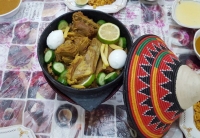
Traditional Food in Najran Province refers to the most renowned dishes prepared by the inhabitants of Najran Province . Most of these dishes have wheat products as their main ingredient. Najran whole wheat is an essential ingredient for the province's most traditional dishes, namely for several baked goods dubbed with various names differing per their preparation and baking. These goods include Kaanoun , also known as al-Mujammar or al-Kurus . The cuisine of Najran and the history of its f...
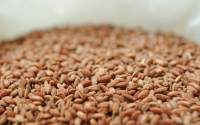
Hasawi Rice is an agricultural crop of al-Ahsa Governorate in the Eastern Province of the Kingdom of Saudi Arabia. Known for its resilience to environmental challenges such as salinity and drought, it is the second most produced crop in al-Ahsa Governorate, following dates. Locally referred to as 'al-'Aysh al-Hasawi,' this rice symbolizes al-Ahsa's cultural identity when served to guests and tourists visiting the historical landmarks of al-Ahsa Oasis , a United Nations Educa...
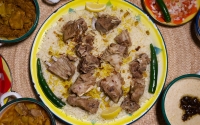
Kabsa is a simple one-pot dish that is easy to prepare. For meat Kabsa, the cooking time is about an hour, while chicken Kabsa takes approximately twenty minutes. The process starts with chopping tomatoes and onions. Butter or oil is added to the pot, followed by spices like cinnamon and loomi, and the mixture is stirred for about ten minutes before adding hot water. The rice is soaked for thirty minutes, washed three times, and then combined with the meat or chicken in the pot. The dish is coo...
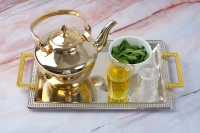
In Saudi culture, some beverages are associated with specific occasions. Some beverages are popular in most regions of the Kingdom of Saudi Arabia while others are specific to a particular region and some are associated with a specific season of the year. These beverages include: Coffee Coffee is the Kingdom's hospitality drink. It is popular in all regions, with some differences in its method of preparation and ingredients. It is also associated with all occasions, whether happy, such as ...
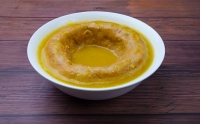
Sago The dish consists of starchy granules known as Sago . They are one of the popular desserts in Gulf countries in general and the Eastern Province , in the Kingdom of Saudi Arabia, in particular. The dish is prepared after soaking the granules in water. Sugar and ghee, amounting to the same quantity of granules, are then added to the mixture. The mixture is then continuously stirred on low heat until it becomes firm. Its preparation requires up to five hours. Al-Marassi' It is one of th...
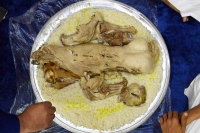
Saudi Kabsa It is considered one of the easiest dishes to prepare technically, as all the ingredients are cooked or pressure-cooked in one pot. However, it reflects the expertise of the cooker in mastering the distribution of spices, how well the meats or added vegetables are cooked, and the perfection of cooking the rice. Haneeth Haneeth dish is associated with the Cissus quadrangularis and Leptadenia trees known in Aseer Province in the southwest of the Kingdom of Saudi Arabia. It is one of t...
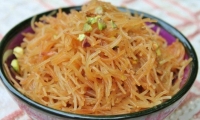
Vermicelli (Shariyya) is a popular dessert known in most provinces of the Kingdom of Saudi Arabia . It is made using vermicelli noodles cut into thin strands. Cardamom and saffron are among the essential ingredients added to the vermicelli. Often, it is served as a dessert dish at lunch or dinner. It is one of the traditional desserts, easy to prepare with simple ingredients, served hot on the table, and sometimes honey is added to it. In the past, preparing vermicelli was not easy, so it was n...
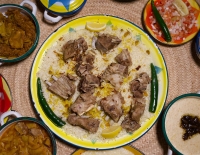
Kabsa is the main meal for lunch in most houses in the Kingdom of Saudi Arabia. The meal, known as 'Saudi Kabsa,' has become synonymous with Saudi Cuisine. Kabsa consists of rice and meat or rice and chicken. Onions are cut into thin slices and fried until they turn yellow. Then, chicken or meat is added and cooked until it turns red. Chopped tomatoes are then added along with cardamom and cinnamon, crushed garlic, other spices, and tomato sauce. Chicken or meat is covered with water ...